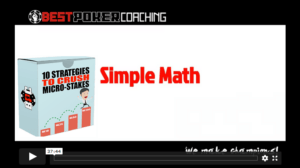As you enter the middle stage of an SNG, some players will have been eliminated and the blinds will have increased to the point where they are a greater portion of your total stack. Sitting around at this stage of the tournament is a strategic mistake and you have to start to be more aggressive and get yourself in a position to win the tournament.
| Have you read part 3 of this series? If not, click here to read: 60-Minute Master SNG Middle Stages |
So what changes at this stage? As players are eliminated and the blinds are increasing, play starts to become more aggressive. Seeing flops with low pairs and suited connectors is no longer profitable because the implied odds of hitting a big hand are reduced and the ability to draw is nearly gone. When the blinds reach 100/200 and six players remain (typical for that level), the average stack is about 2,300. If someone raises to 600 preflop, calling with a hand like 76s or A6s (hoping for a big draw) is wasteful. You won’t hit the draw anywhere near often enough to risk one fourth of your stack preflop. (This assumes starting stacks of 1,500.)
Since the table is short handed, waiting for good hands (or taking flops with mediocre ones) means you’re going to be one of the shorter stacks, not one of the larger. Ideally, you want to get to the bubble stage (four players left) with 4,000 or so chips. Since you will probably go around the table three times while playing down from six to four players, the blinds alone will knock your 2,300 average stack down to 1,400. That won’t work, so you must do one of three things.
In the middle stages, you’re looking for a position where you can either:
- Stealing the blinds
- Get all-in with a coin flip or better
- Get a bad preflop call from another player when you raise with a good hand.
Blind steals are fairly important at this stage. If you were fairly passive in the early stages, not raising the players on your immediate left too much (without big hands, anyway), your raises at this level will get a little more respect. If you raise with any two cards from the button, standard ABC players will likely only defend their blinds about 20% of the time (and only a few of those will be reraises). That means your steal raise has a 64% chance of success from the start. You can reasonably expect to get in one or two successful steals at this level and remember that each time you steal successfully then that covers the cost of the blinds for one whole circuit of the table which buys you more time to wait for a good hand to play.
FLIPPING FOR STACKS BEFORE THE BUBBLE
All in on a coin flip means taking a hand that is either a pocket pair or two big cards, like AT-AK, and reraising all-in against someone that previously raised the pot. This gives you two ways to win the pot, which are:
- The original preflop raiser is scared of your 3-bet and folds, or
- they call and you win anyway.
To be clear, most pairs are slight favorites against two big cards (88 is a slight favorite over AK) when both are all-in before the flop. Yes, it is possible that you will go all in with 88 and get called by 99-AA, but you can’t be afraid of monsters under the bed, but instead, take calculated risks at times to be a long-term winner.
GET CALLED WITH A PREMIUM HAND
You raise with a premium hand, and another player makes the mistake of calling. Even worse for them is if they actually hit part of the flop but with your hand still in the lead. By the way, you cannot lay down premium pairs here. You do not have a stack deep enough to determine if someone got a lucky flop on you. True, you can lay down JJ if someone bets into you on an AKQ flop but in general with premium pairs at this stage of the tournament you are either looking to double up or get knocked out and move onto your next SNG. Your prime objective for the middle stage of an SNG is to survive through to the bubble stage with at least 4k chips in your stack. You will learn about bubble strategy in the next lesson.
WANT TO REVIEW PREVIOUS LESSONS?
If you’re just jumping into this 60-Minute Master series for SNGs or would like to review what you’ve learned so far, here are the links to all previous lessons. If you have questions or comments, please feel free to do so in the comments section below.



